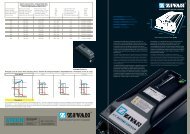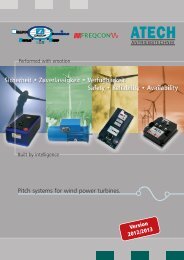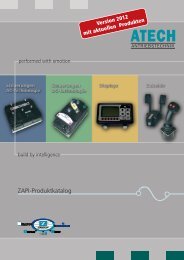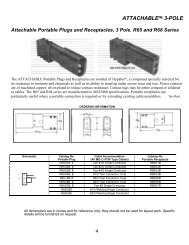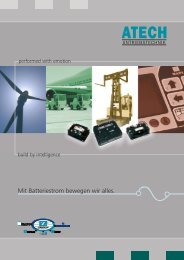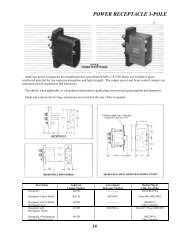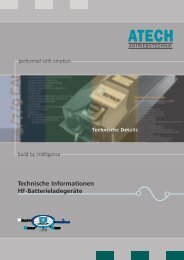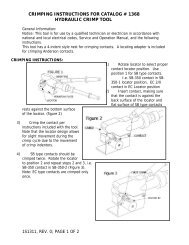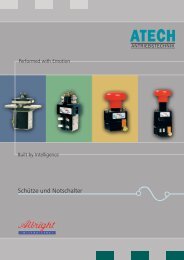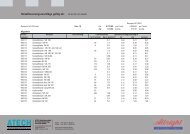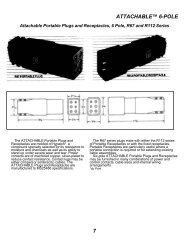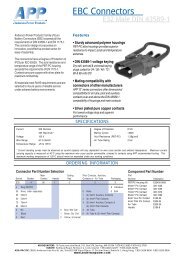Batteriestecker - Atech Antriebstechnik
Batteriestecker - Atech Antriebstechnik
Batteriestecker - Atech Antriebstechnik
You also want an ePaper? Increase the reach of your titles
YUMPU automatically turns print PDFs into web optimized ePapers that Google loves.
SECTION 1<br />
Technical Reference<br />
| General Application Notes |<br />
There are common considerations when using APP ® connectors. Additional considerations may apply based on the<br />
particular connector being used, the application, and conditions in which the connector is being used. This information<br />
is intended to provide a basic understanding and is provided for reference only. APP ® connectors should be assembled<br />
and used according to the equipment manufacturer’s instructions, as well as in compliance with local and international<br />
electrical codes.<br />
The maximum amperage ratings provided in the specifications are based on use of APP ® recommended assembly<br />
tooling and the maximum wire size for the connector being used. Amperage ratings are based on not exceeding the<br />
maximum operating temperature of the connector housing, factoring in an ambient temperature of 25°C or 77°F.<br />
A wire with an appropriate insulation temperature rating should be selected to meet or exceed the total connector<br />
temperature (heat rise + ambient).<br />
As an example: if the maximum operating temperature for a connector operation is 105°C and the ambient temperature<br />
is 25°C, the maximum heat rise attributable to the connector is 105°C - 25°C = 80°C. The expected heat rise based<br />
on the connector and wire size used can be estimated using the heat rise charts, but should be confirmed by testing<br />
in the specific application with the specific wire to be used.<br />
Connector devices are rated or derated by the wiring configuration and the environment. Factors to be considered include:<br />
enclosure characteristics, connector housing and wire insulation characteristics, number of wires in an enclosed area<br />
such as a raceway or conduit, as well as the ambient temperature.<br />
Underwriter Laboratories Inc. amperage ratings are based on not exceeding the maximum operating temperature of<br />
the connector housing. This means connectors can be extremely hot when used at the UL amperage ratings. For this<br />
reason UL amperage ratings should only be applied to connectors when they are used inside an enclosure not accessible<br />
to untrained persons. Canadian Standards Association ratings are based on not exceeding a 30°C temperature rise<br />
above ambient temperatures. For this reason CSA amp ratings are a good point of reference for connectors that are<br />
user operated. APP ® does not recommend exceeding a 30°C temperature rise above ambient temperatures for connections<br />
accessible during operation to untrained persons.<br />
| How to Read Temperature Charts |<br />
Tempearture Rise at Constant Current Charts<br />
Temperature Rise at Constant Current charts show the associated heat rise<br />
as a result of applied current to the connector. An example of the SB ® 50<br />
Temperature Rise chart is included to follow along with this explanation.<br />
The chart is based on an ambient temperature of 25°C (77°F room<br />
temperature). Accordingly if the temperature °C on the Y axis of the chart is at<br />
30°C, the expected total connector temperature would be 55°C.<br />
Temperature (°C)<br />
60<br />
50<br />
40<br />
30<br />
20<br />
SB ® 50<br />
Temperature Rise at Constant Current<br />
Separate curves are shown for #6, #8, #10, and #12 AWG wire. Interpreting<br />
the curves, if 50 amps are applied continuously to the connector, the heat rise<br />
will be 23°C for #6, 35°C for #8, 55°C for #10, and #12 wire is not suitable for<br />
this amperage.<br />
Where T = Temperature, heat rise is expressed as a ΔT°C.<br />
T ambient - T (ambient + heat from applied current) = ΔT°C.<br />
10<br />
0<br />
0 10 20 30 40 50 60 70 80 90<br />
Amperes Applied<br />
6 AWG 8 AWG<br />
10 AWG 12 AWG<br />
- 4 - www.andersonpower.com<br />
All Data Subject To Change Without Notice



